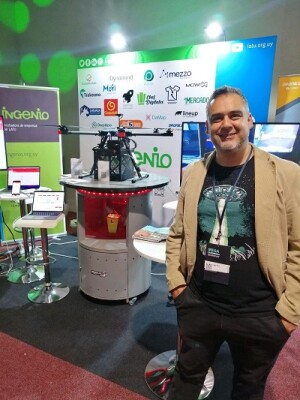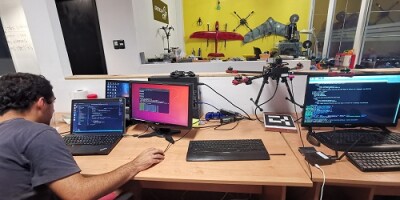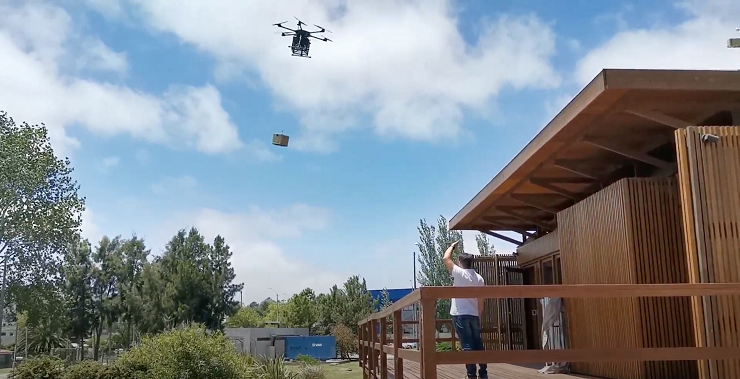The world of entrepreneurship is filled with stories of haphazard encounters, random coincidences, fate, and unlikely alliances that combine to spark an idea and flame the fires of creativity. The industry of uncrewed aviation is exacerbating these combustions by adding the component of a new and exciting technology and the infinite promise of being a pioneer—and perhaps the leader—in a specific field.

People all over the world are abandoning the safety of their jobs and embarking on this new frontier of non-piloted aircraft in a massive, uncoordinated effort to turn traditional aviation on its head with new designs, new approaches, and ingenious solutions to old problems.
This week, we interviewed Diego Silva in Uruguay, the CEO and founder of Drone.uy, an uncrewed aviation company that is going through a fascinating corporate metamorphosis worthy of detailed chronicling.
“My background is in computer science, and I had a nice and comfortable job as an applications developer for an established software house here in Montevideo, but one day in 2016 I saw a race drone on the internet and that gave me an idea,” Silva said. “With some friends, we ordered a couple of racing drones and began practicing and competing against each other.”
The vast availability of components and the relative ease with which to put them together gave Diego and his friends a new idea, one that would prove pivotal in the future of his career.
“We thought we could do a better job at designing and putting together a drone, so we began ordering components and assembling them in our own way and using our software skills to innovate in certain aspects of the operational environment of the newly created aircraft,” said Silva. “Soon, we had the basis for a nascent business, and we founded Drone.uy to seriously explore the possibility of making a living in this new and exciting field.”
Uruguay is an interesting case study for uncrewed aviation given the relatively small size of its geography and the abundance of fields and forests that need constant attention and monitoring. This was the fertile ground where the seed was planted for a formal business venture.
“We toyed with the idea to quit our jobs but were hesitant to make the jump. Then one day our drone design caught the attention of a large pharmaceutical company that formally asked us to develop a drone delivery technology for their products,” said Silva. “That was 2019 when we officially began operations as an independent entity, buying a 3D printer and using our integration skills to develop a truly native and original solution to the problem of medicine deliveries.”
The inherent problem with designing an aircraft (piloted or not) from scratch is that you need permission from the civil aviation authority (CAA) to operate in their national airspace (NAS) in what is known as aircraft certification.
“We worked with the civil aviation authority of Uruguay, Dinacia, as soon as we heard that we needed certification, and they were great, assigning us a group of lawyers to help with two aspects of our idea,” Silva stated. “First, the aircraft certification which involved technological issues such as safety and flyability, while we also worked on the second aspect which was the delivery process and the details of how packages would be retrieved from the vendor and delivered to the end customer. It was a costly process, but we had help.”
 In 2020, Drone.uy received a $70,000 grant from the Uruguayan agency for innovation and development, ANAII, to initiate the new project. Eventually, when the goals were achieved, they were named a “National Interest” company for the Uruguayan government. As soon as Drone.uy received their aircraft certification and the OK to proceed with deliveries, they began daily operations.
In 2020, Drone.uy received a $70,000 grant from the Uruguayan agency for innovation and development, ANAII, to initiate the new project. Eventually, when the goals were achieved, they were named a “National Interest” company for the Uruguayan government. As soon as Drone.uy received their aircraft certification and the OK to proceed with deliveries, they began daily operations.
It is important to point out that these operations were possible because, simultaneously, another company in Uruguay had developed an uncrewed traffic management (UTM) system and was working with Dinacia to make it available to all drone companies in the country.
“We started making deliveries of pharmaceutical products and food and soon realized that the margins were so small and the risks and investments so high that it made us reflect on the viability of the enterprise,” said Silva. “We decided not to quit and looked for another source of revenue, which we found by offering our services to industrial concerns, as opposed to end users in a more business-to-business (B2B) approach we hoped would do the trick and it worked.”
Soon Drone.uy developed a large drone capable of flying 12 miles with a useful load of 44 pounds and then approached public utilities offering a fast service of spare parts deliveries to avoid service interruption in certain rugged areas.
“It was a big hit and we suddenly found ourselves with a profitable business but still struggling to achieve critical mass,” Silva reflected. “At this point, we decided that we would use our technological expertise and our relationship with Dinacia to become a manufacturing concern. By designing and manufacturing solutions for third parties, we found that the margins were better and that gave us the revenue flexibility to survive in a small market. Now we are thinking about expanding internationally.”
One area of particular interest to Silva and his team was how to improve the way that packages were picked up and delivered, so they began working on the concept of small vertiports for delivery companies.
“We had all the expertise and the technology to create a great, self-sufficient vertiport that would accommodate delivery drones at both ends of the route,” reported Silva. “Our design has all the elements that are necessary to serve arriving and departing drones, from battery charging to sensors to communications. We will be selling these vertiports to companies interested in entering the drone delivery industry, not only in Uruguay but other countries in the region.”
What a fascinating corporate evolution from drone racing to delivering food to manufacturing vertiports. Drone.uy is the perfect example of a lean and mean enterprise, willing to evolve and “fail, fast, forward” in order to survive and thrive in this new world of non-piloted aircraft.















Comments